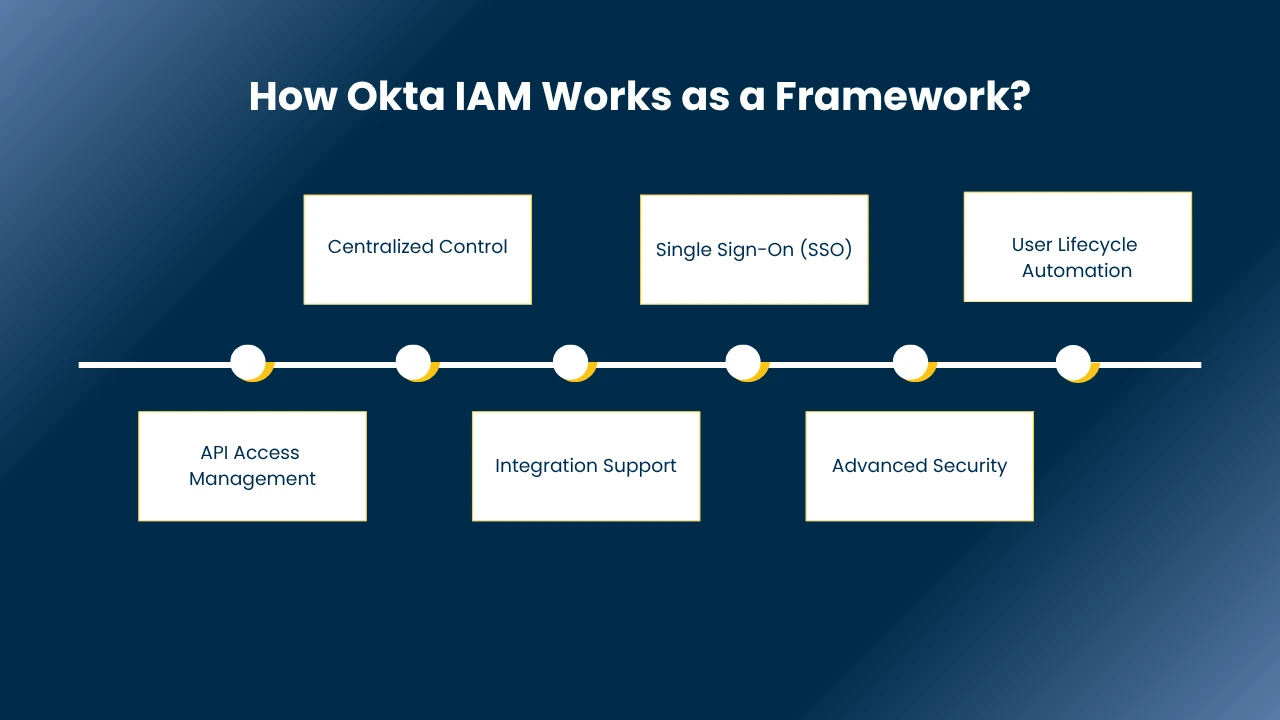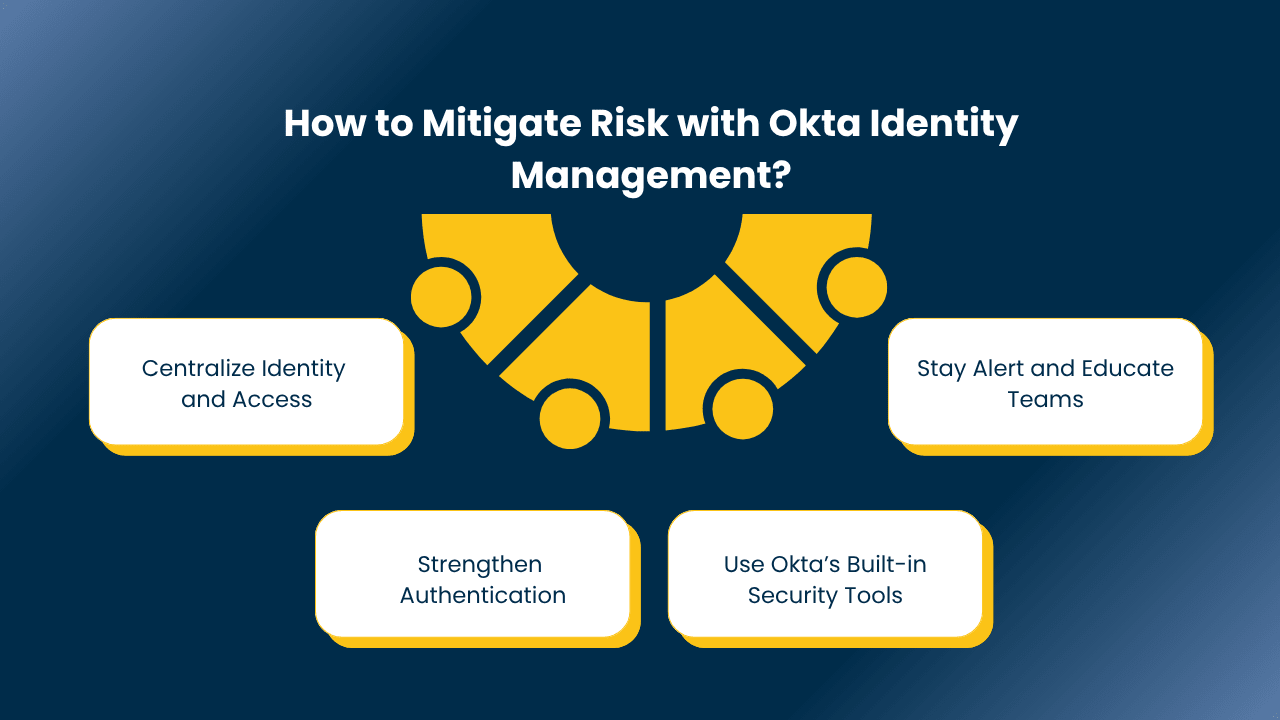What is Okta IAM? Identity and Access Management Explained for 2025

It is very important to manage user access in today’s digital world. Therefore, businesses need strong security to protect data and ensure only the right people can access the correct information. This is where Okta IAM (Identity and Access Management) comes in. Therefore, Okta IAM helps organizations control user identities, manage their logins, and automate their access.
So, whether you are a beginner or a tech professional. You must learn Okta IAM. This will surely help in boosting your career. Furthermore, in this blog, we will discover how Okta works, its key features, and how you can build a strong career with the right Okta IAM training.
What is Identity and Access Management?
Identity and Access Management (IAM) is a type of security system . It controls who has access to an organization’s digital resources. IAM also makes sure that company tools, data, and systems are only accessible by the appropriate individuals, devices, and apps. IAM also creates and maintains digital identities. They implement security rules and set access permissions.
This keeps private data safe from hackers and other unauthorised users. IAM is crucial for employees, contractors, and partners who work remotely as well as in offices. Access can be securely and easily managed with the help of tools like the Okta IAM tool. This keeps companies safe and productive.
All About Okta Identity Management
Okta IAM is a cloud-based identity and access management solution used by companies around the world. It allows organizations to securely manage and control user access to various applications and systems whether they are cloud-based or on-premises. Both employees and customers can use Okta to log in easily and safely.
Okta IAM Key Features
1. Single Sign-On (SSO): Users can access all their apps with one username and password. This saves time and makes the login process smooth.
2. Multi-Factor Authentication (MFA): Okta adds extra protection by asking for additional verification like an OTP, mobile app confirmation, or biometric scan.
3. User Lifecycle Management: Okta automates user onboarding and offboarding, reducing manual work for IT teams.
4. Easy Integration: The tool works with popular SaaS apps, on-premise systems, and even custom-built applications. This gives companies centralized control over all access points.
5. APIs and SDKs: Developers can use Okta’s APIs and SDKs to add secure login and identity management features into their own apps.
6. Identity Engine: Okta’s Identity Engine lets companies customize how users log in and what access they receive.
7. Identity Governance: With this, businesses can control who accesses what, approve access requests, and stay compliant with security rules.
Benefits of Using Okta IAM
1. Better Security: Strong access controls help protect company data from threats.
2. Higher Productivity: SSO and user management save employees and IT teams a lot of time.
3. Lower IT Costs: Automated processes reduce manual efforts and the need for extra resources.
4. Improved User Experience: Logging in becomes easier and faster with tools like SSO and passwordless login.
5. Regulatory Compliance: Okta helps meet legal and security standards like GDPR, HIPAA, and more.
6. Okta IAM Salary: In India, Okta IAM Engineers earn between ₹3.6L–₹11.5L annually, averaging around ₹6L. Salaries vary by role, experience, and company.
Also Read: Master Okta Training in Chennai Online with 100% Placement Assistance
Okta Identity and Access Management as a Framework
Okta IAM is more than just a login tool it acts as a complete framework for managing digital identities and access within an organization. It provides a structured and secure way to make sure the right people can access the right resources at the right time.
Okta IAM framework Key Components
1. Identity Management: Okta helps create and manage user identities with details like roles, departments, and permissions. All identity information stays organized in one place.
2. Authentication: To keep data safe, Okta verifies each user’s identity using Multi-Factor Authentication (MFA) and other secure methods.
3. Authorization: Once a user is verified, Okta decides what they can access based on their role and permissions.
4. Access Control: It applies security rules to ensure only authorized users can perform certain actions or see sensitive data.
How Okta IAM Works as a Framework?
The Okta IAM tool brings all access management tasks into a single, easy-to-use platform. Here’s how it works:

1. Centralized Control: Manage all users and their access in one dashboard across apps, devices, and networks.
2. Single Sign-On (SSO): Let users log in once and access multiple apps—saving time and reducing password fatigue.
3. User Lifecycle Automation: Automatically give or remove access as people join or leave the company.
4. API Access Management: Securely manage how apps communicate with each other using APIs.
5. Integration Support: Okta easily connects with both cloud and on-premise systems, making it flexible for any business setup.
6. Advanced Security: Okta includes features like real-time threat detection, adaptive MFA, and risk-based access decisions.
Why Choose Okta IAM as a Framework?
1. Better Security: Reduces chances of unauthorized access or data breaches.
2. Smooth User Experience: SSO and easy logins make work faster and hassle-free.
3. Saves Time: Automates user access tasks for IT teams.
4. Meets Compliance: Helps follow rules for data protection and privacy.
5. Grows with You: Okta’s cloud platform scales easily as your team or business grows.
Using the Okta IAM tool as a framework gives organizations a strong base for managing access, boosting productivity, and staying secure in today’s digital world.
How to Mitigate Risk with Okta Identity Management?
Managing identity is not just about access it’s also about security. The Okta IAM tool helps organizations reduce the risk of data breaches by using strong security features and smart access control. With the right setup, you can make your systems much safer for both employees and customers.

1. Centralize Identity and Access
- Single Sign-On (SSO): Use SSO so users log in once and access all their apps. This reduces the number of passwords and lowers the chance of password-related attacks.
- Identity Governance and Administration (IGA): Set clear rules on who gets access to what. With proper identity governance, only the right people get access to sensitive data.
2. Strengthen Authentication
- Multi-Factor Authentication (MFA): Always use MFA, especially for admins and remote users. It adds an extra layer of security.
- Phishing-Resistant MFA: Use safer MFA methods like biometrics or security keys to stop hackers from stealing passwords.
- Risk-Based Authentication: Okta IAM features detect suspicious behavior like login attempts from unknown locations and ask for more proof before allowing access.
- Least Privilege Access: Give users only the access they need to do their job. Nothing more.
- Regular Reviews: Review who has access to what on a regular basis. Remove access that’s no longer needed.
Read More: How to Become an IAM Engineer in India in 2025?
3. Use Okta’s Built-in Security Tools
- Sign-On Policies: Create custom sign-on rules that demand extra steps if something seems risky.
- Entity Risk Policies: Monitor logins and adjust risk levels in real time. For example, block access or ask for MFA again during suspicious activity.
- Universal Logout: If there’s a threat, Okta can log users out of all apps and devices at once.
- Okta Identity Engine: This advanced tool helps manage risk with features like adaptive MFA, context-based access, and dynamic risk scoring.
- Okta Integration Network (OIN): Use OIN to connect securely with third-party apps. This keeps your access control consistent across systems.
- API Security: Protect your APIs with access control so attackers can’t steal your data through backend systems.
4. Stay Alert and Educate Teams
- Keep Systems Updated: Cyber threats keep changing. Keep your security policies updated too.
- Test Your Defenses: Run regular audits and security checks to find weak spots before attackers do.
- Train Your Users: Teach your team about strong passwords, phishing scams, and the importance of reporting suspicious activity.
By using the Okta IAM tool the right way, companies can improve their security, protect sensitive data, and avoid costly breaches. The key is to stay proactive, automate where possible, and always review access regularly.
Conclusion
Strong identity and access management is the need of the hour for every modern business. Okta IAM offers an effective way to manage who gets access to your systems, ensuring security without slowing things down. Its features like SSO, MFA, and automated user management make it a complete solution for any organization. The Okta IAM tool not only improves protection but also makes IT processes easier and faster. To take full advantage of this technology, consider enrolling in Okta IAM training and earn an Okta IAM certification to boost your career.
Understand how Orbus can help your career!
Speak with an Expert Now!
FAQ's
What is Okta and IAM?
Okta is a cloud-based tool that helps manage user identities and control access to apps and systems. IAM (Identity and Access Management) is the broader process of managing who can access what in a secure way.
What is the difference between Okta and SAML?
Okta is an IAM platform that supports various login methods. SAML (Security Assertion Markup Language) is a protocol used by Okta to enable Single Sign-On (SSO) between users and apps.
What are the 4 pillars of IAM?
The four main pillars are:
- Identification (knowing the user)
- Authentication (verifying identity),
- Authorization (granting access)
- Accountability (tracking user actions).
What is Okta used for?
Okta is used to manage user logins, secure access to applications, enforce MFA, automate user onboarding, and support Single Sign-On across cloud and on-premise systems.




